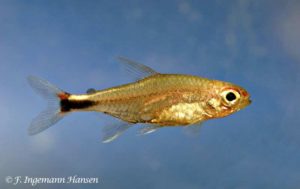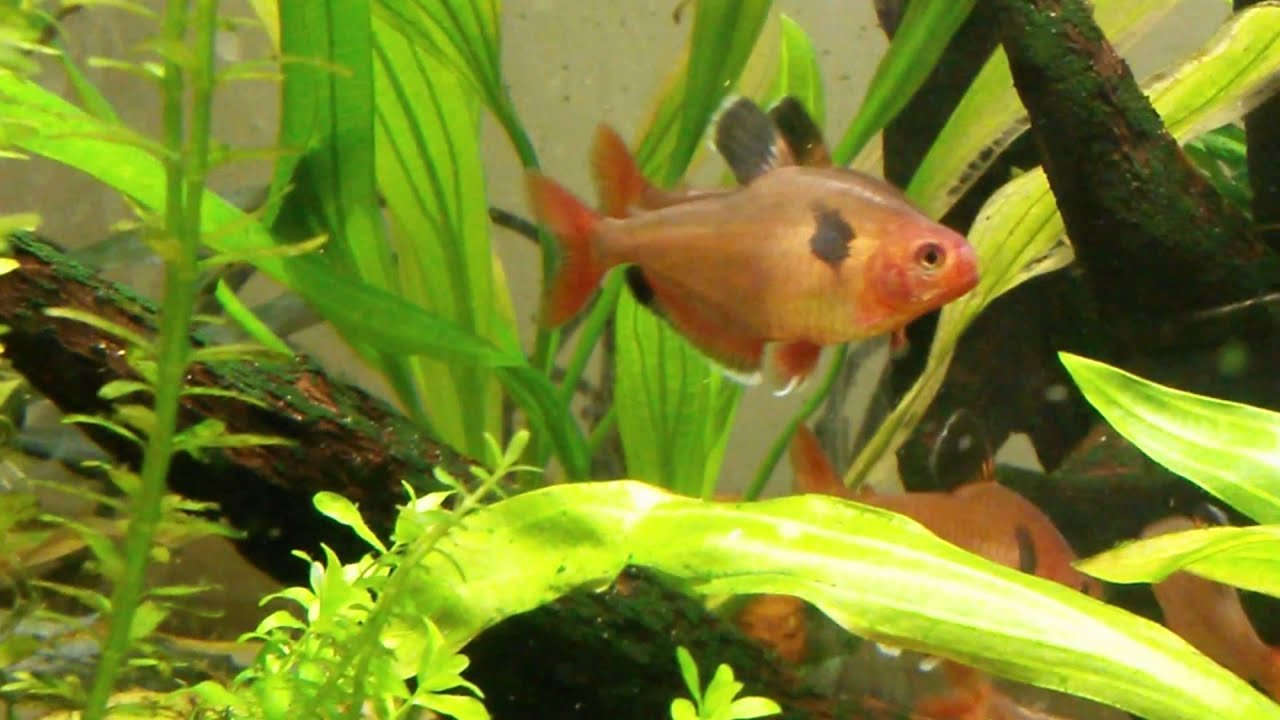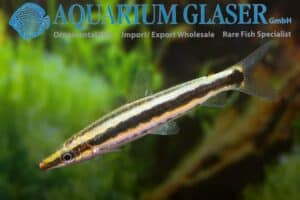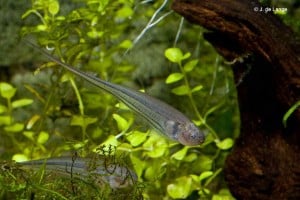Megalamphodus eques – Juwel Tetra
Megalamphodus eques was first described by Steindachner in 1882. Their common name is Juwel Tetra. This fish belongs to the family of American Tetras, the Acestrorhamphidae, and falls under the order Characiformes (carps) within the Teleostei (bony fish).
The genus name Megalamphodus is derived from Greek: ‘megas’ or ‘megalos’ means ‘large’, ‘amphi’ means ‘on both sides’, and ‘odous’ means ‘teeth’. The meaning of the species name eques probably comes from Latin and means ‘horseman’ or ‘rider’, referring to the marking on the flank that resembles a saddle. Steindachner did not explain the name in his first description, but also gave this name to two other species with saddle-like markings: Nannostomus eques and Abramites eques.
Synonyms: Cheirodon eques, Chirodon eques, Hyphessobrycon callistus, Hyphessobrycon eques, Hyphessobrycon serpae, Tetragonopterus callistus, Hemigrammus melasopterus, Hemigrammus serpae.

Description
The Juwel Tetra is a relatively small freshwater fish that reaches a maximum length of approximately 3 to 6 centimeters. Its body shape is typical of a tetra, with a streamlined body that allows the fish to move quickly in its natural habitat.
The main color of this species is red. The intensity of this red color can vary. A vertical black spot can be seen on the flank. The dorsal fin is mostly black in color. The anal fin often has a black edge.
There are clear differences between the sexes: males are generally more intensely colored and have a distinctive elongated dorsal fin. Females are generally slightly larger and have a rounder and thicker body than males.
Behavior and temperament
The Juwel Tetra is known as a semi-aggressive fish. They are not always very tolerant, especially when they are hungry, and can harass other inhabitants. It is therefore important to feed them sufficiently.
These fish are schooling fish and should be kept in groups of at least 6 and no more than 12. If the group is too small, they can become intolerant and focus on the fins of other fish, resulting in “fin biting.” Within a group of Juwel Tetra, there is often roughhousing and fighting for dominance, which means that there is almost always a fish with damaged fins. Although they can harass other species, they rarely cause more than a few broken fins.
When feeding, larger groups of Juwel Tetra can behave like a school of piranhas, diving so fiercely for food. They mainly stay in the middle layer of the water, between 5 and 20 centimeters above the bottom.
It is not advisable to keep Juwel Tetra together with fish that have long fins or barbels, such as Betta, Angelfish, and Gouramis, because the Juwel Tetra will eat their fins and barbels. Peaceful eaters and species that value their peace and quiet are also not suitable to combine with the Red Minor, as this species can be very active in a tropical aquarium.
Life expectancy
The Juwel Tetra has a life expectancy of approximately 5 years in the aquarium.

Biotope
The Juwel Tetra is a freshwater fish native to South America. The species is widespread and found in countries such as Brazil, Bolivia, Peru, Paraguay, and Argentina. Specific locations in Brazil include the Ibicuí River basin and watercourses along the banks of the Rio Uruguay in the state of Rio Grande do Sul. The species has also been observed in the Laguna dos Patos system and the Gravataí River basin in southern Brazil, although its presence there may be the result of introduction by human activity, such as escapes from aquariums or fish farms.
Type of water and habitat description
The Juwel Tetra is a habitat generalist and lives mainly in stagnant waters and slow-flowing tributaries, ponds, and small lakes. They can also be found in rivers, streams, and flooded areas, such as the Pantanal plain in the upper Paraguay River basin.
The natural habitat of the Juwel Tetra is characterized by rich vegetation. The fish often form small groups around the shore vegetation or seek shelter among submerged tree roots, where they can hide safely and find food. Dense edge planting and floating plants, such as Salvinia, contribute to a subdued and shady atmosphere that is characteristic of their natural habitat. The substrate often consists of dark sand or gravel, supplemented with leaf litter (such as dried oak or beech leaves) and (drift) wood or branches, which mimics the natural environment. The water flow in these areas is usually weak to moderate.
Natural enemies or role as hunter
The Juwel Tetra is a carnivorous fish. Due to its relatively small size (3 to 4 cm), the species tends to be discreet and hide in the presence of larger fish. The Juwel Tetra is known to fall prey to larger fish or crustaceans.
Climate
De Rode Minor komt voor in Zuid-Amerika, wat duidt op een tropisch klimaat. De vermelding van overstromingen in Brazilië in de maanden september, november, april en mei suggereert dat de soort leeft in gebieden die onderhevig zijn aan seizoensgebonden regenval en periodieke overstromingen, wat typisch is voor veel tropische riviersystemen.
Distribution and habitat
The distribution area of the Hyphessobrycon eques is very large and extends from the Rio Parana in the southern part of Paraguay to the Orinoco drainage in Venezuela and covers almost the entire Amazon river. The habitat consists of the major rivers to small streams and flood plains. As a result, there are also many different living conditions in which this species occurs from clear water with many plants to black water with lots of wood and leaves.
Behavior and compatibility
Hyphessobrycon eques is a species that is best kept in groups of a minimum of 6 to a maximum of 12. They usually swim between 5 to 20 centimeters above the bottom and are often frolicking and fighting among themselves. As a result, there will always be one or more fishes with tore fins and other species are not always safe, but usually it won’t get any worse then that. When they are being fed, they can act like a school of small piranhas, dashing at the food. Because this species has a very large distribution area it can be kept together with subtropical as well as tropical species although this species will be very active in a tropical tank. Slow eaters and species that appreciate more calm companions are not suitable to combine with Hyphessobrycon eques.
Aquarium
Because of the mutual frolicking / fighting for dominance and their active eating behavior, I recommend a minimum aquarium length 100 centimeters. Decorate the aquarium with lots of plants and wood, breaking the sight lines. Water parameters are not that important as this is a very hardy species capable of coping with a wide range of water conditions.
Diet
In the wild this species is omnivorous and eats anything from small insects and fry to algae and fruit that has fallen into the water. In the aquarium it will readily eat anything you feed it. Just provide a variety of foods like flakes, frozen or living foods to keep them healthy.
Sexing and breeding
Sexing the Hyphessobrycon eques is not very difficult. Adult females are somewhat larger and somewhat rounder / thicker. Breeding will not be very successful in a community aquarium as they will eat their own eggs and fry. Fry only have a slim chance to survive if you provide lots of cover.
If you would like to have more fry left over, it is advisable to start a separate breeding tank with a bottom of marbles or artificial grass and/or many fine plants such as Java moss so that the parents cannot eat the eggs. The tank should be dimly lit and the water soft and slightly acidic. Subsequently, a pair or group of well-fed adult fish can be placed, which will be removed after spawning (possibly the next morning). Remove the parent animals after 3 days at the latest, as you may miss/overlook the eggs when spawning. When you see that fry have hatched, you can start feeding them with brine shrimp naupli and dust food. Especially in the first weeks it is wise to feed a lot of brine shrimp naupli to allow the fry to grow quickly.
Video
Author
Jos Rollman
Copyright images

















